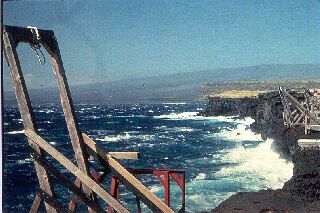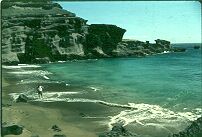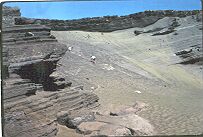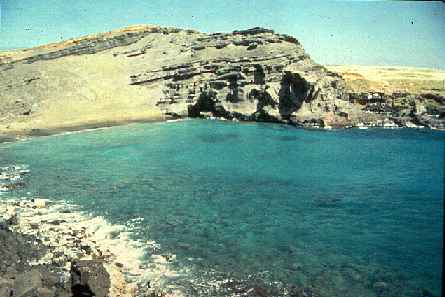 Now we were ready for the big
time--the Green Sand Beach of the Big Island, a 2-1/2 mile hike
from the end of the road at South Point. Not a mystery, clearly
visible on most maps. But getting there would be a challenge.
Now we were ready for the big
time--the Green Sand Beach of the Big Island, a 2-1/2 mile hike
from the end of the road at South Point. Not a mystery, clearly
visible on most maps. But getting there would be a challenge.
IN WAR TIMES, Kathleen's latest novel (Tor, May 2007, ISBN 13: 978-0-765-31355-3) is set, partially, in the Pacific (Honolulu and Oahu, the Big Island, and Midway) during the early sixties. Her father was then inspecting the setups for the new IBM system, the DEW line, which were also used by the newly-formed NASA. It has starred reviews from Publisher's Weekly, Kirkus, and Booklist. Peter Straub says "IN WAR TIMES is a novel of great historical reach -- from the Battle of the Bulge to the Kennedy assassination and beyond -- and profound ambition, expressed with an unmistakable ease of execution and a master's sureness of touch. Kathleen Goonan has come through to the kind of control that makes every startling fresh development, and this novel bristles with astonishing moments of development, seem inevitable. Not only does Goonan know that Charlie Parker and Dizzy Gillespie changed the world, she understands that every vision of the future conceals a deep yearning for one's own specific past. That's real wisdom."
In
Search of
the Green Sand Beach
by
Kathleen Ann Goonan
Black sand beaches are not uncommon in Hawaii--how could they be? From the air the Big Island is rivered with what look like the black, flowing tresses of Pele, rooted at the summits of Moana Loa or Moana Kea. Mix well with surf for several thousand years and see what happens. Black sand.
And we'd searched out the mysterious Red Sand Beach of Hana, the seawashed interior of a red cinder cone, a favorite of nudists. That took detective work--it's practically in the center of town in Hana, but like many other aspects of Hana, its beauty is in its hiddenness.
 Now we were ready for the big
time--the Green Sand Beach of the Big Island, a 2-1/2 mile hike
from the end of the road at South Point. Not a mystery, clearly
visible on most maps. But getting there would be a challenge.
Now we were ready for the big
time--the Green Sand Beach of the Big Island, a 2-1/2 mile hike
from the end of the road at South Point. Not a mystery, clearly
visible on most maps. But getting there would be a challenge.
I had been to South Point before, alone, following in the footsteps of my father thirty years after his visit. That had been in 1960, when he was on an inspection tour for the Navy. I well remembered seeing his home movies of The Big Island flickering in our Oahu house, especially where he panned "Highway 1"--a rutted, muddy road, isolated and remote. "There wasn't much there," he told me lately, referring to his visit to South Point. There isn't much there now. Nothing but sea, sky, and windswept, lonely fields stretched over a skin of soil the lava has grudgingly yielded over countless centuries.
South Point is a peninsula sacred to the Hawaiians, filled with a sense of mana--power. The first settlers were said to land here, and one counts them enormously fortunate. The next stop is Antarctica. The current toward the frozen south is so powerful that the lava cliffs at South Point have thousand-year-old niches carved in them where fishermen tethered their canoes with lines long enough to take advantage of the excellent fishing which these blue depths still offer and be able to safely return to shore.
On my next visit--my first one in person--I scuttled down a rutted, but paved, single-lane road in a rental car, thus voiding my contract (the road is forbidden to rental cars). Beneath the science-fictional shadows of a flock of hundred-foot-tall white windmills which pulled power from the very air with whining whirrs grazed a few oblivious cows. Three or four houses are on the twelve-mile road, including one which begged prospective buyers to stop in to the perpetual open house with pleading signs.
The black lava cliffs at land's end have three canoe winches bolted to weathered scaffoldings. The sea is stunningly blue in the equatorial light, smashing in huge blue swells against the land. The wind is strong and constant. The sparse trees lean--into it or beneath it, I was not sure.
Just before the point proper, the road forks. The left fork, even more tattered than the right, leads to a concrete boat launch past the open foundations of an old military outpost graciously left by an old tsunami.
On that visit, I took a brief run over the lava flats to stand on a small ridge, and gazed over an endless deserted coastline filled with the clear tidal pools so inexplicably dear to my heart. The Green Sand Beach was somewhere down there, where my guidebook warned that only four-wheel-drive vehicles dared go. I felt uneasy walking alone in the vast terrain--in Hawaii, one needs to exercise the same care which one exercises in the middle of any large city.
Isolated coves beckoned, to the end of vision. Gently undulating hills spoke with rutted, empty roads of the play of four-wheel-drive adventurers. How I wanted to go!
Five years later, my husband Joseph and I set out from our hotel on the North Kona coast quite early. There's not much there, so distance is somewhat deceptive, but we figured it would take several hours.
The road rises from coast-level quickly, past Kailua, and soon gives the sensation of flight. The slopes of these volcanoes are so gradual and smooth that no ridges intervene between you and the ocean, only miles of swiftly sloping green smooth land, and later, coarse black lava fields. In the early morning chill of coffee country, the world seemed primordially bright and new. Jungle-like tropicality abounds, in impenetrable clumps of banana trees, and in the flowers which overflow the lava rock walls lining the road.
Lazily, we had first thought of simply driving to the Green Sand Beach. We called several companies which advertised that they rented four-wheel-drive vehicles, but none of them officially allowed the lessee to take the vehicle to the Green Sand Beach. "Just rent a little pickup and don't tell them where you're going," said the speaker, a woman, at one of the companies. "It will make it there all right. The road's not bad." We finally located one in Kailua but it was enormously expensive and besides, the walk was an inviting prospect.
After several hours of travel, which included stops at every coffee outlet, we arrived at the end of the road at the boat launch, the left fork when you near the end of the point. One must always have an eye for car break-ins in Hawaii. On Oahu's north shore, my brother-in-law left his car unlocked, and his glove compartment open to show that there was nothing to steal. One of the locks was smashed anyway. At McKenna beach on Maui, one late afternoon, we returned to our car to find that the trunk lock had been punched in--indeed, all the cars parked beneath the trees suffered the same indignity. So we took nothing to South Point which we could not do without.
In the green field which sloped down to the water, which contained several empty boat trailers and a few empty cars, we readied ourselves. We had in our pack sandwiches from a sub shop, cold drinks, bathing suits, and towels. I packed my camera, of course. We chose to leave our snorkeling equipment behind--a mistake. And then we set off.
There were only a few spots which truly required four-wheel-drive--jagged lava ledges and deep ruts. But the walk was flat and easy. Surrounded by vistas of ocean-rimmed isolation, I was deeply happy. The constant Kona wind rustled the dry grasses and low sedges which comprise the fields of South Point. The faint, sweet smell of them mingled with the tang of the sea. Huge waves dashed themselves against cliffs just yards away. Tropical wilderness.
But not entirely, not as wild as Kalalau on Kauai's north coast. The dirt roads which braid through the fields hook up again with blacktop twelve miles hence. We saw several hikers. I decided that I would not hesitate to hike this alone, though our hiking book warns against it strongly.
We saw our destination a mile before we reached it. Rising out of the multitudinous folds of land, the cinder cone is a mottled quarter-sphere arching dramatically from the oceanside fields.
Our guidebook warned against trying to climb down the loose sand of the north side. On the south a break in the gnarled lava rock offers handholds and descends to a good trail which hugs the cliff, above gleaming black lava flats filled with the white ebb and flow of powerful waves.
The bay was clear, lucid turquoise. Two fellow hikers perched, tiny on an outcropping of rock beneath the steep north wall far off across the bay. On our way down to the beach we passed a niche where a solitary camper had left the scattered contents of his open pack,and a bright blue down bag airing in the morning sun.
 The beach itself, on an island
which boasts few good beaches, was a joy. Smooth, sandy, the
power of the surf tempered by the narrow mouth, the sun lit the
shallows teal-green as we descended. We swam without fear (my
fear, in the Hawaiian Islands, after being swept past the reef by
a wave during the 1960 International Surfing Championships, being
the very common rip tides and the oft-ignored hazard of high
surf) in the gentle waves, and wished that we had brought the
snorkeling gear. The water was perfect. We did not find another
spot fit for snorkeling, due to rough and cloudy conditions,
during the entire ten days we were there.
The beach itself, on an island
which boasts few good beaches, was a joy. Smooth, sandy, the
power of the surf tempered by the narrow mouth, the sun lit the
shallows teal-green as we descended. We swam without fear (my
fear, in the Hawaiian Islands, after being swept past the reef by
a wave during the 1960 International Surfing Championships, being
the very common rip tides and the oft-ignored hazard of high
surf) in the gentle waves, and wished that we had brought the
snorkeling gear. The water was perfect. We did not find another
spot fit for snorkeling, due to rough and cloudy conditions,
during the entire ten days we were there.
After swimming, we pulled two bottles of beer and sandwiches from our pack, and ate shielded from the stinging, wind-driven sand in the shadow of a rock.
The small bay is the inner cone of a small volcanic cone which was composed of olivine. Reach into the water and hold a handful of wet sand against the sunlight, and the pale green hue sorts itself into tiny black peppers of surf-scoured lava, and billions of tiny green translucent jewels of olivine, dulled only by collusion with their more golden neighbors.
 In due course, a couple peered
over the center of the rim, several hundred feet above us. After
conferring with one another, a decision was apparently reached,
for the woman handed the man a full-sized ice chest over the rim,
and he began to inch his way down. "Take his picture,"
shouted Joseph from where he bobbed on the waves, his body quite
clear though wavery through the turquoise water. "He's going
to fall. The book says not to come down that way."
In due course, a couple peered
over the center of the rim, several hundred feet above us. After
conferring with one another, a decision was apparently reached,
for the woman handed the man a full-sized ice chest over the rim,
and he began to inch his way down. "Take his picture,"
shouted Joseph from where he bobbed on the waves, his body quite
clear though wavery through the turquoise water. "He's going
to fall. The book says not to come down that way."
Not wanting to take advantage of the poor fellow's potential indignity, I merely stood and watched, like a dullard. After five minutes of struggling in the steep, loose sand, finding it impossible to ascend, he stumbled beneath his load as if on cue. Twelve beers rolled down the pale green slope, closely followed by the man and the tumbling, open ice chest. A woman in a bathing suit came bounding down behind him, carrying towels. She did not fall. On ascending to the rim, we saw that they had arrived by truck.
The Green Sand Beach has visitors, but not many. It is said to be a favorite for nude bathing, which is illegal in Hawaii, but a couple we saw on our way out, returning from an early morning visit with their mats rolled and carried under their arms, had availed themselves of the relative privacy of the beach. While there, we saw four other people. We saw few--perhaps eight--on our entire hike, including a party of truck campers just one cove past the boat launch.
The Green Sand Beach is an easy five-mile round trip hike from the boat launch at South Point. You can't miss it. Just drive to the southernmost point in the United States and head east.
You won't regret it.
WAYS AND MEANS
Many maps of the Big Island depict perfectly passable roads which say, "Rental Cars Prohibited Past This Point." Even places which rent four-wheel-drive vehicles may tell you that you may not take their vehicle to South Point.
To be on the safe side, if you decide to drive to the Green Sand Beach, there is one place in Kailua which will allow you to drive there. There are no treacherous cliffs, no impassible places with no turn-around--at least, not on the first 2 1/2 miles, so your driving skills won't be unduly challenged by the terrain. And with a vehicle, you can explore the rest of this remote coast.
But why go to the expense and trouble, unless you have difficulty walking, or intend to drive further? Just take plenty of water and sunscreen. The journey is as exhilarating as the destination.

THIS SHARED DREAM |
IN WAR TIMES|
QUEEN CITY JAZZ | THE BONES OF TIME | MISSISSIPPI BLUES | CRESCENT CITY RHAPSODY | LIGHT MUSIC |Novellas & Short Stories
| Selected Book Reviews | Travel | Interviews & Signings | Orders | Links | Guests | Email | Home
Originally published in the Washington
Post
Copyright © 1992 Kathleen Ann Goonan All
Rights Reserved.